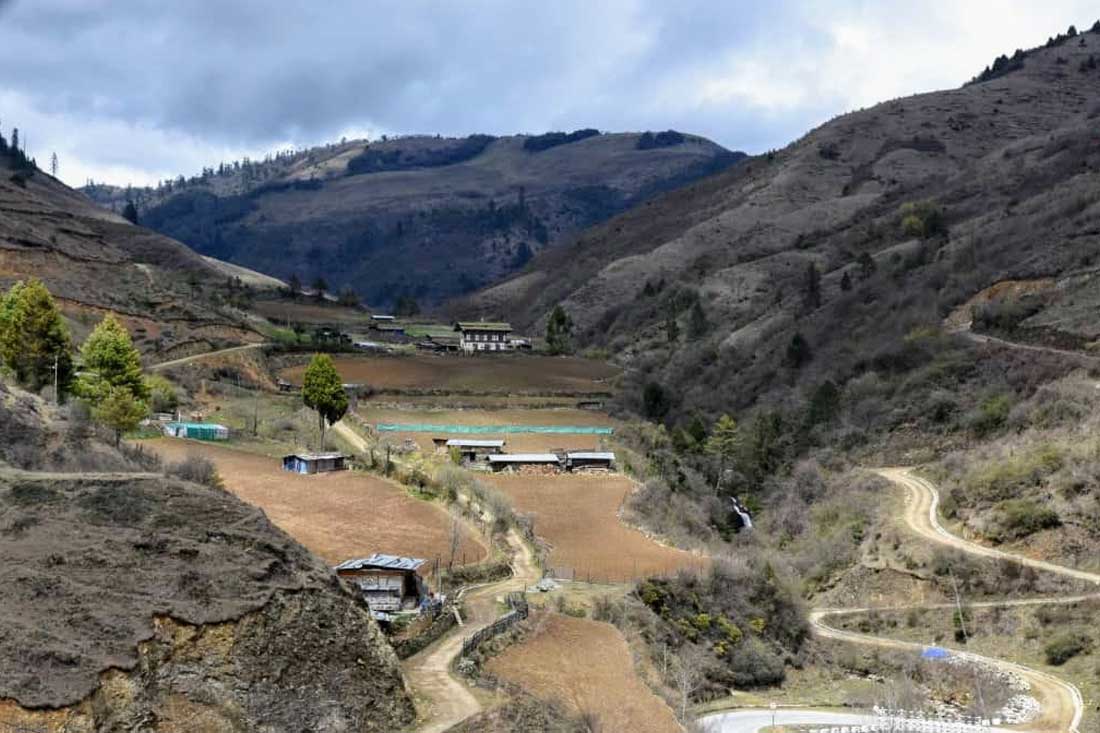Why Book Your Trip Now?
- Visa Approved Within 24 Hours – Get your Bhutan visa fast, once your booking is confirmed.
- Guaranteed Departures – No cancellations. Your adventure is locked in and ready to go!
- Group Discounts Available – Traveling with friends or family? Enjoy special rates when you book as a group.
Calendar & Prices
General
General
General
General
General
General
General
General
General
General
General
General
General
General
General
General
General
General
General
General
General
General
General
General
Details
Day 01: Lingmukha Valley
Your guide will meet you at your hotel in Punakha to begin your exploration of the Trans Bhutan Trail. You’ll trek east through rice paddies, stopping for lunch at a chorten with beautiful views. In the afternoon, you’ll descend into Lingmukha Valley to visit a temple built by Tertoen Dorji Lingpa. Spend the night in a Trans Bhutan Trail campsite and have the chance to enjoy a traditional hot stone bath. The trek covers a distance of 12.5 km in approximately 7 hours, with an elevation gain of 1,123 meters and a maximum elevation of 2,190 meters.
Day 2 :Lingmukha - Samtengang
After breakfast, continue along the Trans Bhutan Trail with your guide, following the path of the locals from Lingmukha and Phangyul. Hike through the rainforest and stop at a mountain pass with beautiful views of the Shar Valleys. Visit Chungse Azhe Gyalzom temple and learn about its connection to Drukpa Kuenley. Enjoy lunch at a local restaurant in Chungseykha village, then continue hiking through farming villages to Samtengang. Spend the evening relaxing at your campsite under the stars. The trek covers 17.2 km in about 8 hours, with an elevation gain of 1,286 meters and a maximum elevation of 2,535 meters.
Questions & Answers
What languages are spoken in Bhutan?
There are 19 languages spoken in Bhutan, but the national language is Dzongkha. English is used throughout Bhutan’s education system, so it is widely used and understood.
What is the weather like in Bhutan and when is the best time to visit?
Bhutan is a year-round destination. There are four seasons: summer (June to August), autumn (September to November), winter (December to February) and spring (March to May). But because of the range of altitudes in the country, and the influence of the north Indian monsoons, the climate is incredibly varied.
In the south, the humid, subtropical climate is fairly consistent year-round, with temperatures between 15oC and 30oC. Central Bhutan, with its temperate forests, has a more seasonal climate, with warm summers and cool, dry winters. The northern regions are much colder during winter. Because of the high altitude, mountain peaks are snowy year-round and the lower reaches remain cool in summer.
In summer, the Indian monsoon season runs from late June or July to late September, mostly affecting the southern regions. Most farming activities take place in the summer, when crops thrive in verdant landscapes.
Autumn, from late September or early October to late November, follows the rainy season. It is characterised by bright, sunny days and some early snowfall at higher elevations. It’s the season of feasts and festivals as farmers reap the fruits of their work.
From late November until March, the crisp, clear and sunny winter sets in, with frost throughout much of the country and snowfall common above elevations of 3,000 metres. The winter northeast monsoon brings gale-force winds at the highest altitudes through high mountain passes, giving Bhutan the name Drukyul, which means Land of the Thunder Dragon in Dzongkha (Bhutan’s national language).
Bhutan’s generally dry spring starts in early March and lasts until mid-April. It is a botanist’s delight, with nature in full bloom. Summer weather commences in mid-April with occasional showers and continues to late June.
What currency is used in Bhutan?
Bhutan’s currency is called ngultrum. It’s 1:1 with Indian rupees.
Which power plug is standard in Bhutan?
Three different electrical plugs are used throughout Bhutan: the British plug (three square pins, compatible with type G sockets), the European plug (two round pins, compatible with type C socket) and the Indian plug (three thick round pins, compatible with type D sockets). It’s a good idea to bring adaptors for all three.
What is the international country code?
For telephone calls, Bhutan’s country code is +975. Make sure you add this to the beginning of any number if calling Bhutan from abroad.
Do I need a visa to enter Bhutan?
Visitors of all nationalities, except those from India, require a visa before entering Bhutan. For all visitors, except those from Bangladesh and the Maldives, this visa must be applied for and approved in advance of travel. Visitors from Bangladesh and the Maldives also require a visa, but this can be applied for and approved either in advance of travel or upon arrival in Bhutan.
Visitors from India are able to apply for a permit but are required to hold an Indian passport or an Indian voter ID card. For Indian nationals under the age of 18, a passport or a birth certificate can be used to enter and they must be accompanied by a legal guardian.
Nationals from Switzerland and Thailand holding diplomatic or government-official passports are eligible for a visa at their port of entry.
How do I apply for a visa?
How long does my visa allow me to stay in Bhutan?
The visa allows you to remain in Bhutan for a maximum of 90 days from the date of entry.
How can I plan my trip to Bhutan?
If you would like to book completely independently, there are plenty of online resources for inspiration, research and booking – including this website. There are lots of experienced, accredited tour operators that can help you too. Please check our website https://services.bhutan.travel/ for a full list of DOT-certified Tour Operators, hotels and guides.
Our host team is also on hand to help provide you with information as you plan your journey.
How can I get to my hotel from the airport?
You can take a taxi from the taxi rank outside the airport or organise an airport transfer with your hotel or tour operator. There is no other public transport available at the airport.
What is the SDF and how is it used?
The Sustainable Development Fee (SDF) is a daily levy paid by visitors to support Bhutan’s development. Since the kingdom first opened its doors in 1974, guests have played a critical role in our country’s growth.
The SDF is collected by the national exchequer and funds are allocated to various projects that create long-term, sustainable opportunities for the Bhutanese people, through free healthcare, education and training, upskilling the tourism and hospitality industry, improved infrastructure, environmental preservation and conservation, cultural preservation programmes and initiatives that support local businesses and economies. The SDF is also a vital means of maintaining the exceptional forest cover and carbon-neutrality for which our small nation is world-renowned and globally critical. The SDF also helps us to ensure that we can continue to offer guests tranquillity and an intimate experience.
How much is the SDF?
he SDF is USD 100 per night for adults from all countries except for India. Children aged between 6 years and who have not yet turned 12 are eligible to pay USD 50 per night. Children who have not yet turned 6 years old do not have to pay any SDF.
The SDF for Indian nationals (showing a valid Indian passport or Voter ID card) is Nu. 1,200 (or the equivalent amount in Indian rupees) per person, per night. Children aged between 6 years and who have not yet turned 12 are eligible to pay Nu./INR 600 per night. Children who have not yet turned 6 years old do not have to pay any SDF.
How much cash can I bring into Bhutan?
You may bring cash equivalent to US$10,000 into the country.
Are permits required to enter National Parks in Bhutan?
Yes, permits are required to enter National Parks in Bhutan. However the process can be done online and the permit should be issued quickly. Please visit this link for more information: https://docs.google.com/forms/d/e/1FAIpQLScM4k5SPaGI_GnV6NJuQHstpS5ai9




